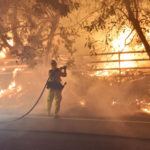On a bitterly cold morning in Anchorage, Alaska, the Hurricane Hunters lift off to scout a weather track that may bring snow to the Northeast or flooding rains in California in the next five days.
The winter mission of the Hurricane Hunters, based at Keesler Air Force Base in Biloxi, is as well known in other parts of the country as their daring flights into hurricanes are to those living along the coastlines. Both missions save lives and millions of dollars.
Lt. Col. Jonathan Talbot, aerial reconnaissance weather officer for the 53rd Weather Reconnaissance Squadron assigned to Keesler’s 403rd Wing, said the Hurricane Hunters generally improve a forecast by 15 percent, saving cities in the Northeast large amounts of money on snow removal and emergency response.
“Winter weather kills more people than hurricanes do,” he said, because those storms affect a larger portion of the country.
A study by the University of South Carolina shows 18 percent of deaths from natural hazards each year are caused by winter weather. That’s compared with less than 5 percent from earthquakes, wildfires and hurricanes combined.
The Hurricane Hunters have two winter missions — flying Gulf and East Coast storms from Keesler and tracking Pacific storms from either Alaska or Hawaii with the same WC-130J planes used in tropical storms.
“It’s a totally different scenario,” Talbot said. “In hurricanes we actually physically fly through the storm, flying as low as 1,000 feet above the water up to 10,000 feet in a full-blown hurricane. The Hurricane Center needs the information for that altitude.”
The National Weather Service asks the Hurricane Hunters to collect data for its winter forecasts from altitudes as high as 34,000 feet down to the surface. Identical dropsondes are launched from the planes in summer and winter, measuring temperature, wind speed, humidity and pressures as they parachute to the surface on their single trip.
In 2005 the Hurricane Hunters’ tropical- and winter storm missions overlapped when the final storm of the hurricane season came in early January 2006. This year the squadron was deployed to fly the first winter storm of the season on the East Coast a week before Christmas.
Talbot said the team flies over the water, where there aren’t any weather stations. From Keesler they fly mainly East Coast Nor’easters that get a lot of their energy from the ocean and have a big impact on cities from Washington to Boston.
Talbot said the Pacific Ocean is so huge the Hurricane Hunters share their mission with the National Oceanic and Atmospheric Administration.
“If they’re in Alaska, we’re in Hawaii,” he said, although this year NOAA is flying from Japan. The Hurricane Hunters are citizen airmen who have other jobs in South Mississippi and around the country, and fly as reservists. Talbot said they take two planes, along with heavy coats and boots, on these monthlong deployments to Alaska.
“If you collect the right information at the right place _ over the Pacific Ocean _ you can make a big impact to the forecast four to five days later,” he said.
Topics Catastrophe Natural Disasters Hurricane Mississippi Alaska
Was this article valuable?
Here are more articles you may enjoy.


 ‘Surface Waters’ on Roof Are Not ‘Flood’ Waters, Massachusetts High Court Rules
‘Surface Waters’ on Roof Are Not ‘Flood’ Waters, Massachusetts High Court Rules  Insurers Face Business Interruption Claims After Global Tech Outage
Insurers Face Business Interruption Claims After Global Tech Outage  How California’s Homeowners Insurance Crisis Is Affecting Brokers
How California’s Homeowners Insurance Crisis Is Affecting Brokers  Applied Systems Acquires Insurance AI Platform Planck
Applied Systems Acquires Insurance AI Platform Planck 

